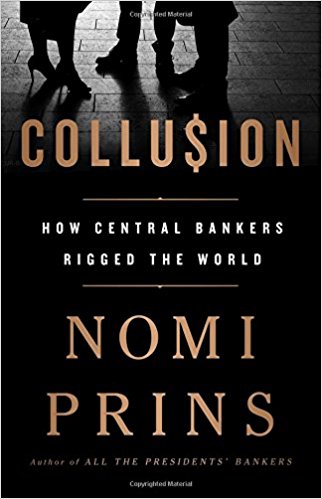Two time best-selling book author and TalkMarkets contributor Nomi Prins, says the rescue policies of the 2008 financial crisis are still with us today.
 Prins is out with a brand new book called “Collusion: How Central Bankers Rigged the World.” The enormity of our current global debt problem is caused by central bankers. Prins explains, “It is huge. The debt is between two and a half to three times global GDP, which is an historical high. Debt to GDP throughout the developed world is higher than it has ever been, and it continues to grow. Why? Because money continues to be conjured up and rendered cheap for the participants at the top of the financial system.
Prins is out with a brand new book called “Collusion: How Central Bankers Rigged the World.” The enormity of our current global debt problem is caused by central bankers. Prins explains, “It is huge. The debt is between two and a half to three times global GDP, which is an historical high. Debt to GDP throughout the developed world is higher than it has ever been, and it continues to grow. Why? Because money continues to be conjured up and rendered cheap for the participants at the top of the financial system.
The banks, the major corporations, the people who make money out of that, and it hasn’t washed down to the rest of the economy. This is why most people feel this anxiety about another potential financial crisis, but also about what happens every day in their own pocketbooks. So, it is worse. These central banks today, 10 years after the financial crisis occurred, that was supposed to be an emergency situation. They have $21 trillion worth of conjured money in return for debt assets, stocks and corporate bonds around the world.If they pulled that plug, if they were to take down any of the $21 trillion, even a little bit . . . it would begin to create a major rupture in the financial system. This is why I say the central banks are the market. Without them, the markets would be nowhere near these highs. If they pulled their help and subsidies, the market would plummet really quickly.”
Prins admits this has gone on for longer than most believed possible, but says it can’t go on forever. How does it all end?Prins, who was a former top Wall Street banker, says, “We will eventually get a crash because, at some point, the amount of quantitative easing, or conjured money to buy assets out of the market to pump up the . . . financial system, will come to this head where even though these major central banks are continuing to dump money in. There will be ruptures at the bottom of the economy . . . even though they are borrowing cheap money, they just can’t make enough money to service very cheap debt.











Leave A Comment